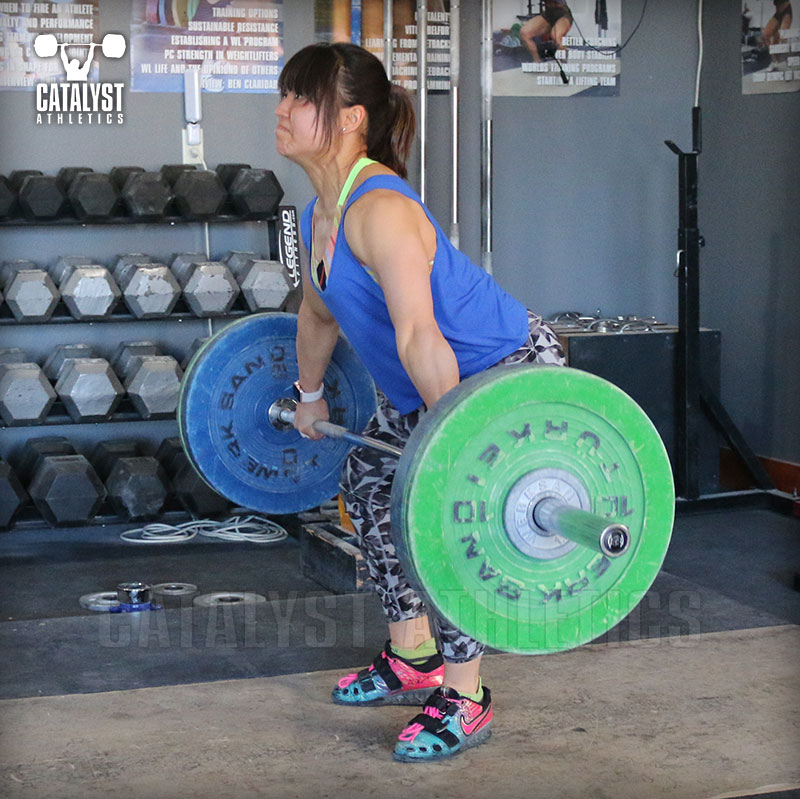Ask Greg: Issue 177

Ricky Asks: My question is about programming variations in the lifts. Certain variations like hangs don’t seem to ever translate to the classic lifts for me. But blocks and pauses do, so is that something I should just incorporate more and cut out what doesn’t work? Or just follow what’s on the program and just try to figure out why it doesn’t work (bad position from the variation, etc)? Thanks.
Greg Says: The short answer is yes—use what works and don’t use what doesn’t. This is true for exercises and program design.
The longer answer is that there are a few things to consider when making the decision. Different lifters respond to a given exercise differently, and each lifter needs to focus on different things to some degree based on their particular weaknesses. This being the case, you always need to be evaluating what an athlete needs to work on and determining what exercises best solve that problem. This won’t necessarily be the same for an entire career—as the athlete develops, certain aspects may outpace others, or changes in technical execution may require strengthening somewhat different positions, etc.
Before abandoning an exercise because it appears to not translate to improvements in your classic lifts, be sure of two things:
First, that you’re doing the lift correctly. This is the most common problem in these cases. No exercise is maximally effective without decent execution. Using the hang lifts example you give, it’s typical for lifters to not be able to figure out the position they need to be in, and on top of that, the position tends to be inconsistent rep to rep. For the hang lifts to translate, they need to be strengthening and reinforcing the optimal positions and movements for the related competition lift; if they’re not, it’s not even just a matter of their not helping, but it’s actually counterproductive to an extent by being confusing in terms of motor learning.
Second, that it not working isn’t indicative of a weakness or problem you need to resolve. For example, in some cases a lifter is fine from the blocks, but can’t execute hang lifts from the same position well because of a lack of postural strength to support that position. This would indicate a weakness that should be addressed, as it may actually be limiting the competition lift by preventing the athlete from staying over the bar as long as is optimal, and this may just not be apparent in the competition lift itself.
As long as you’ve cleared those two things, don’t feel required to do any given exercise if you find it unhelpful, even if it’s commonly used by lifters.
Greg Says: The short answer is yes—use what works and don’t use what doesn’t. This is true for exercises and program design.
The longer answer is that there are a few things to consider when making the decision. Different lifters respond to a given exercise differently, and each lifter needs to focus on different things to some degree based on their particular weaknesses. This being the case, you always need to be evaluating what an athlete needs to work on and determining what exercises best solve that problem. This won’t necessarily be the same for an entire career—as the athlete develops, certain aspects may outpace others, or changes in technical execution may require strengthening somewhat different positions, etc.
Before abandoning an exercise because it appears to not translate to improvements in your classic lifts, be sure of two things:
First, that you’re doing the lift correctly. This is the most common problem in these cases. No exercise is maximally effective without decent execution. Using the hang lifts example you give, it’s typical for lifters to not be able to figure out the position they need to be in, and on top of that, the position tends to be inconsistent rep to rep. For the hang lifts to translate, they need to be strengthening and reinforcing the optimal positions and movements for the related competition lift; if they’re not, it’s not even just a matter of their not helping, but it’s actually counterproductive to an extent by being confusing in terms of motor learning.
Second, that it not working isn’t indicative of a weakness or problem you need to resolve. For example, in some cases a lifter is fine from the blocks, but can’t execute hang lifts from the same position well because of a lack of postural strength to support that position. This would indicate a weakness that should be addressed, as it may actually be limiting the competition lift by preventing the athlete from staying over the bar as long as is optimal, and this may just not be apparent in the competition lift itself.
As long as you’ve cleared those two things, don’t feel required to do any given exercise if you find it unhelpful, even if it’s commonly used by lifters.
| Greg Everett is the owner of Catalyst Athletics, publisher of The Performance Menu Journal and author of Olympic Weightlifting: A Complete Guide for Athletes & Coaches, Olympic Weightlifting for Sports, and The Portable Greg Everett, and is the writer, director, producer, editor, etc of the independent documentary American Weightlifting. Follow him on Facebook here. |
Search Articles
Article Categories
Sort by Author
Sort by Issue & Date
Article Categories
Sort by Author
Sort by Issue & Date

